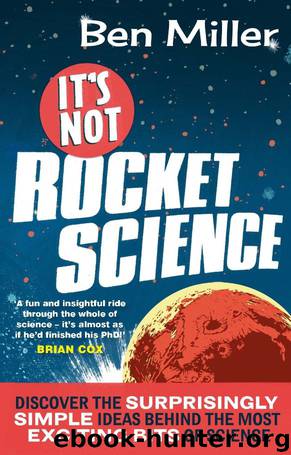It's Not Rocket Science by Ben Miller

Author:Ben Miller [Miller, Ben]
Language: eng
Format: epub, mobi
ISBN: 9780748128501
Publisher: Little, Brown Book Group
Published: 2012-07-12T00:00:00+00:00
I once met Francis Crick, one of the two men who famously figured out the structure and function of DNA. I was a graduate student at the Cavendish, and Rachel Weisz’s mother Edith was giving a garden party for him at her home in Cambridge. Edith had known him since the sixties, when apparently he had been something of a butterfly on the Cambridge social scene. It was in the summer of 1990, and he cut quite a dash, a silver fox with a pinch of Harry Potter wizard. I joined a conga-line of fellow students, all eager to unlock the secrets of the Universe, but kind of fluffed it by telling him all about how I had hallucinated by smoking banana skins when I was a teenager. This wasn’t as random as it sounds, as I knew he was researching human consciousness, but all I can remember is him smiling kindly while no doubt wishing for a rather higher human consciousness to interact with.
Just as when I was introduced to Paul McCartney at a Steve Coogan gig and I shut myself in the loo rather than ask him what it was like to be in the Beatles, I probably did the right thing. Paul McCartney probably isn’t the best person to tell you about the Beatles, just as Neil Armstrong probably isn’t the best man to tell you about what it was like to walk on the Moon. Some people, after all, are just too close to the action to be able to appreciate quite how extraordinary their achievements are. And in the search to understand the origins of life, Crick and Watson were about as close to the action as it is possible to get.
Back in the early 1950s, everyone’s hunch had been – correctly – that it was the chromosomes of a cell that were the seat of heritability. Chromosomes are made of DNA, and it was Crick and Watson, who had been shown a sneak preview of an X-ray diffraction pattern of a DNA molecule obtained by rival Rosalind Franklin, who managed to deduce that it had a double-helix structure, a bit like a twisted ladder. It’s easier to draw than to describe so I’ve had a go above, next to my drawing of a cell.
Not only did Crick and Watson solve the riddle of DNA structure, they also cracked the DNA code. If DNA is like a ladder, then the ‘sides’ are made of alternating sugar and phosphate groups. Attached to each sugar is one of four different bases: adenine, thymine, guanine and cytosine. Let’s not worry too much about what they are, because to understand the code we can just call them by their first letters, A, T, G and C. The bases join together to make the ‘rungs’; A always joins to T and G to C.
And here’s the truly astonishing bit. The bases form a code, and our bodies are capable of unzipping a DNA molecule right up the middle, reading that code and using it to make proteins.
Download
This site does not store any files on its server. We only index and link to content provided by other sites. Please contact the content providers to delete copyright contents if any and email us, we'll remove relevant links or contents immediately.
Spell It Out by David Crystal(35347)
Professional Troublemaker by Luvvie Ajayi Jones(28964)
We're Going to Need More Wine by Gabrielle Union(18072)
The Secret History by Donna Tartt(16623)
Cat's cradle by Kurt Vonnegut(13867)
The Goal (Off-Campus #4) by Elle Kennedy(12433)
The Social Justice Warrior Handbook by Lisa De Pasquale(11489)
The Break by Marian Keyes(8605)
Crazy Rich Asians by Kevin Kwan(8349)
Thirteen Reasons Why by Jay Asher(7788)
The remains of the day by Kazuo Ishiguro(7551)
Educated by Tara Westover(7061)
The handmaid's tale by Margaret Atwood(6852)
Win Bigly by Scott Adams(6311)
Giovanni's Room by James Baldwin(5878)
This Is How You Lose Her by Junot Diaz(5771)
Six Wakes by Mur Lafferty(5203)
The Rosie Project by Graeme Simsion(5189)
The Last Black Unicorn by Tiffany Haddish(5075)
